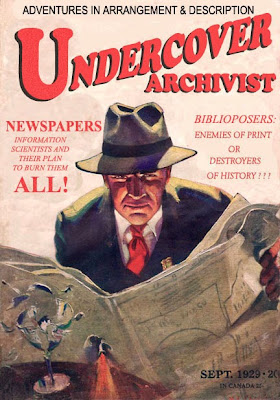Libraries have been treating newspapers like bird cage liners for decades, taking yesterday’s edition from the little sticks on the hanging rack, throwing it onto a pile of its fellows in the corner for a week or two, and then putting today’s copy on the stick to start the process all over again. Eventually the stack in the corner had its purgatory status resolved by either being fed into the hell of the recycle bin or taken to the heaven of the microfilm room. Alas, the stop under the camera was only an illusory paradise, for after its filming the stack found its way to the rubbish anyway. Writer Nicholson Baker decried the practice as recently as two decades ago, but libraries and archival allies responded vehemently to Baker’s grousing, pointing out the ephemeral nature of newsprint demanded its migration to microfilm for long term preservation. Besides, argued the librarians, we don’t have the space to store all those stacks of crumbling dailies after their text is rendered onto a compact reel of silver halide film.
Fast forward to the new world order of the Information Scientist and the Biblioposer. To these nefarious characters even microfilm is a waste of space and their never-ending conspiracy to change “things” into “zeros and ones” has given them an argument for pitching even microforms into the insatiable “we-are-going-green” dustbins. Never mind the fact that microfilm can be read with no more fancy equipment than a candle and a magnifying glass, to the Information Scientist anything not on the screen is junk taking up space. In fact, with newspapers turning more and more to an online rather than physical presence, we can cut out the middleman entirely and simply “archive” the web pages of the New York Times.
Somehow that option leaves us cold here at True Archives. We are prepared to work undercover to save these artifacts and insist that the best place for microfilm and its “floppy disk” cousin, microfiche, is with us where it can be safely stored amidst other three-dimensional information bearing objects. While they are at it, let the “libraries” also give us their microform reading machines too; after all, those dinosaurs are just getting in the way of the computers.

No comments:
Post a Comment